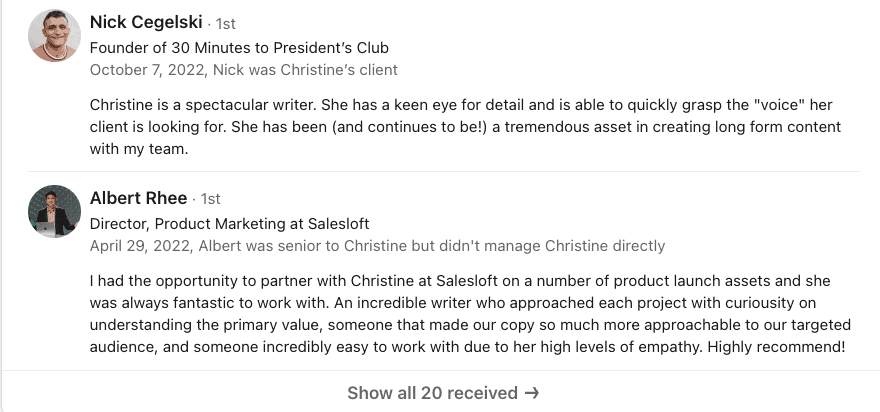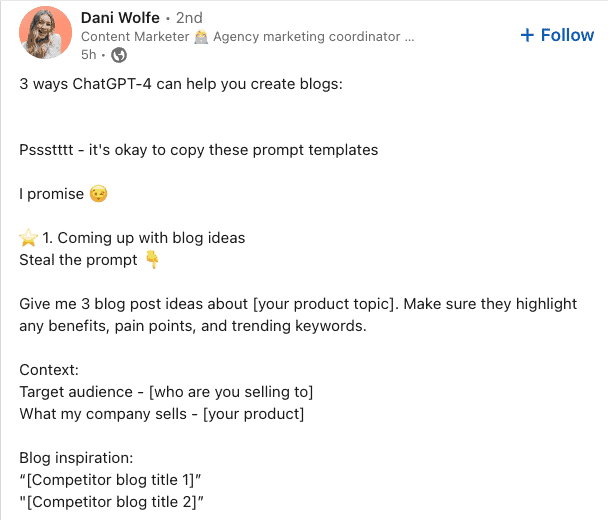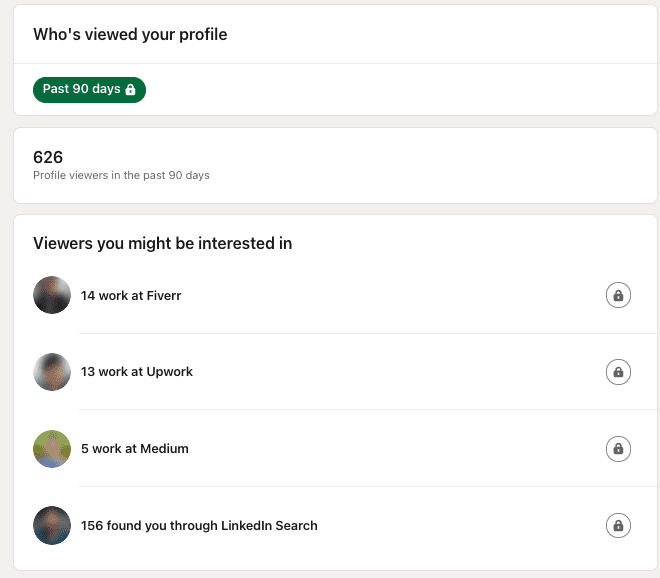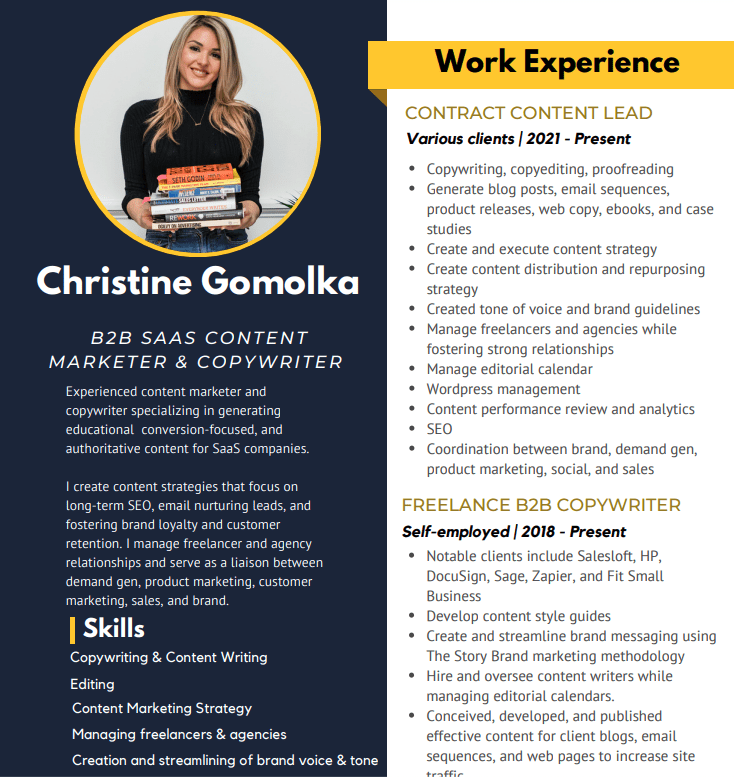
Freelancing on LinkedIn? Yes, you read that correctly. While LinkedIn is the go-to for landing full-time roles, many underestimate how much of a goldmine it is for obtaining and securing freelance gigs without the hassle of sifting through countless job boards.
As of 2023, more than 58.4 million companies are on LinkedIn and three new members sign up on LinkedIn every second! Needless to say, LinkedIn is the ideal platform to get exposure for your freelance work and reach your ideal clients.
If you’re ready to unlock the true potential of your freelancing career and thrive in this competitive market, keep reading to learn the secrets of using this powerful tool to land high-quality freelance opportunities.
How to freelance on LinkedIn
LinkedIn’s 774+ million members span 200 countries, making it a powerful platform for establishing global connections and reaching a broad range of potential clients and industry leaders.
By optimizing your profile, building a strong network of relevant connections, and searching for opportunities and decision-makers, you can generate a steady flow of clients and stop dealing with freelance dry spells.
1. Optimize your LinkedIn profile for freelance opportunities
Having your LinkedIn profile optimized for freelance opportunities is crucial, so that prospective clients not only find you but also begin to trust you. The internet is overwhelming, and with thousands of freelancers competing for the same job, it’s no longer enough to just have a LinkedIn profile. You need a well-optimized profile to stand out and effectively target your ideal clients.
The value in optimizing your LinkedIn profile lies in how its search functionality and algorithm work. Like Google, LinkedIn’s search results are determined by a ranking system based on relevance. Basically, the more relevant your profile is to the searched keywords, the higher it appears in the search results. This is referred to as LinkedIn’s Search Engine Optimization (SEO).

To show up in search results and appeal to your ideal clients, focus on optimizing the following sections.
Photo
Your LinkedIn profile picture is the first thing anyone sees when they come across your profile, so make sure it’s professional and approachable. Invest in a high-quality headshot that captures your natural appearance or at least opt for good lighting and a clean background.
Dress in attire that reflects your profession and smile to convey warmth and likeability. According to LinkedIn, profiles with a photo receive 21 times more profile views and 9 times more connection requests.
Title / Headline
Your headline is crucial in attracting potential clients as it serves as your tagline on LinkedIn. Employ a clear and concise headline that highlights your expertise and specifies the freelance services you offer.
Use keywords relevant to your field and ensure it communicates your unique value proposition. For example, instead of writing “Freelancer”, consider “Freelance Graphic Designer – Helping Brands Create Impactful Visuals”.
Job Title
When listing your freelance job title, be specific and include industry-relevant keywords that prove you know the industry lingo and buzzwords. Ensure your job title effectively communicates your services and expertise, helping you reach your target clients more quickly.
Write a Personality-Driven ‘About’ section
Your “About” section should give potential clients a glimpse into your personality and work principles. To create a compelling LinkedIn summary, begin by crafting an enticing opening, followed by a brief overview of your experience, and end with a call to action.
Let your personality shine through by showcasing your unique freelance journey and sharing why you’re passionate about your work. This section will showcase your writing style and tone to differentiate you from others in your niche.
Professional Experience
Your work history section should reflect your competence and expertise as a freelancer. Include the most relevant experience to your target audience, focusing on projects and accomplishments that demonstrate the value you bring to clients. Use specific examples, quantitative results, and notable milestones to fortify your credibility. If you have past job non-freelance job experience that relates to your freelance skills and work, you can leave it on your profile.
Creator Mode
LinkedIn’s creator mode feature lets you promote your freelance offerings through a curated carousel of posts or articles. Leveraging this feature will help you amplify your voice, share content highlighting your skills, and engage with your audience.
With creator mode, your “Featured” and “Activity” sections move to the top of your profile, enticing potential clients to explore your work and engage with your content.

Skills
Your skills section should accurately represent the strengths that make you the ideal freelancer in your field. Prioritize your top skills that directly relate to your freelance services. You can receive endorsements from others about your skills, which validates your expertise to potential clients.
According to LinkedIn, listing 5 or more skills increases your chances of being contacted by recruiters or other LinkedIn members by 33% and increases profile views by 17x!
Pro tip: Identifying the right keywords (industry-specific terms, technical jargon, software, and relevant soft skills) is vital in attracting your ideal clients. LinkedIn’s algorithm scans your profile to determine how closely it matches the searched terms. Strategically place relevant keywords throughout your profile, including your headline, summary, job titles, and skills.
2. Build your LinkedIn network with relevant connections
You are ranked on LinkedIn based on the connections you have. The algorithm considers the searcher’s degree of connection to you (1st, 2nd, or 3rd) and evaluates the relevance of your connections to the searcher. The wider and more relevant your network, the higher your chances of appearing in search results.
3. Ask for recommendations (testimonials)
Asking your LinkedIn connections for recommendations and displaying them on your profile enhances your credibility and increases your chances of attracting new clients. Remember, a well-curated LinkedIn profile can be the deciding factor for potential clients when choosing to work with you, so it’s worth investing time and effort into building a strong online presence.

Here’s how to strategically ask for recommendations on LinkedIn to strengthen your freelance profile:
- Identify the right people.
Start by creating a list of connections who can provide substantial, relevant, and genuine recommendations. Focus on clients and colleagues who have direct experience working with you on specific projects and managers or supervisors who can vogue for your skills and performance.
- Personalize your request
Instead of sending a generic message to all your connections, take the time to craft a personalized message for each person. Mention the project or role you worked together on and the skills or achievements you would like them to emphasize.
- Make it easy for them
Provide your connections with a few bullet points highlighting key aspects of your collaboration. This gives them an idea of what to write about and helps ensure their recommendation is specific, relevant, and convincing.
- Don’t be afraid to follow up
People are busy and may forget to respond to your request. It’s perfectly acceptable to send a polite follow-up message after a week or two, reminding them of your request and expressing your appreciation for their time.
- Offer to reciprocate
If you’ve had a positive working experience with your connection, offer them a recommendation. This creates a mutually beneficial relationship and reflects positively on your professional character.
6. Regularly update your recommendations
Just like you’ll periodically update your portfolio, keep your recommendations up-to-date by seeking new testimonials from recent clients and projects.
4. Upload your resume for easy job application
Although freelancers rarely have traditional resumes, you can still make the most of LinkedIn’s job application feature by reaching out to opportunities by keeping a resume handy.
Instead of focusing on a chronological work history as you would with a traditional resume, create a document that highlights the milestones, expertise, and value you bring to potential clients.
5. Use the search feature
As a freelancer, you should take advantage of the advanced search capabilities of LinkedIn to find potential clients and pitch your services to them. Here are some strategic methods to maximize the use of LinkedIn’s search feature:
Use Boolean operators
LinkedIn’s search engine allows Boolean operators (words like AND, OR, NOT) to refine your search results. Boolean search terms use keywords to generate more accurate results. For example, freelancers looking for content writing projects can enter “content AND writing” to identify relevant prospects.
Apply search filters
LinkedIn offers several filters to narrow down search results, including location, industry, company size, job function, and more. You can use these parameters to find potential clients in your target markets. For example, if you’re a freelance web designer, you can filter by industry to look for prospects in the technology, marketing, or design sectors.
Search for decision-makers
To secure freelance projects, it is crucial to target those who make hiring decisions within a company. Freelancers can search for positions such as CEOs, Directors, Managers, and Founders by including those terms in their search queries.
Also, pay attention to taglines or endorsements on profiles, as people highlight their hiring authority there.
Utilize advanced search operators
The search feature offers further enhancements with advanced search operators, such as title, company, and school. For instance, a graphic designer may search “title:Creative Director” to find individuals who likely require their services.
6. Engage with relevant content on your feed
LinkedIn’s algorithm favors users who are active and engaged on the platform. As such, it evaluates factors like the recency of your updates, frequency of engagement (likes, comments, and shares), and the quality of your content. A well-optimized LinkedIn profile should demonstrate that you are an active participant in your field, connecting and engaging with relevant professionals.
As an introvert who doesn’t post content on LinkedIn, I rely heavily on engaging with other people’s posts!
7. Create engaging content to attract your ideal clients
Many freelancers consistently publish content that showcases their expertise, creativity, and problem-solving abilities to attract ideal clients. By utilizing short-form and long-form content, you can effectively demonstrate your value to potential clients and elevate your freelance business.

Here are some tips and ideas to help you create engaging LinkedIn content that resonates with your target audience:
Focus on your niche
The most successful freelancers on LinkedIn are those whose content is laser-focused on their niche or industry. For instance, if you’re a freelance web designer, share articles, tips, and news related to the subject. By positioning yourself as an expert in your field, you’ll attract clients who need your services.
Share valuable insights
Provide quick tips, factoids, or statistics relevant to your industry. This can pique the interest of potential clients and spark conversations with fellow professionals.
Comment on industry news
Stay informed about the latest developments in your field and share your thoughts on these subjects. This not only signals your commitment to staying current but also showcases your ability to apply critical thinking and analyze real-world events.
Engage with your audience
Encourage engagement by asking open-ended questions or polls related to your niche. This not only helps with the algorithm, but it also helps you learn the needs and preferences of your target clients to uncover new opportunities for your freelance business.
Write educational articles
Share in-depth articles that teach readers something new or valuable about your industry. These articles should be well-researched, well-written, and demonstrate your expertise. This will not only attract your ideal audience but also position you as a thought leader in your niche.

Share case studies or success stories
Provide real-world examples of how you’ve helped clients achieve their goals or overcome challenges. These stories should include details about the client’s problem, your approach, and the results you helped them achieve. This type of content inspires trust and confidence in your abilities as a freelancer.
Utilize storytelling
Effective storytelling can make your content more engaging and relatable. Share personal anecdotes or experiences that helped shape your professional journey. This can connect you with potential clients on a deeper level and set you apart from competitors.
8. Monitor your profile views and search appearances
Check your profile views and search appearances, and then strategically connect with industry decision-makers viewing their profile or interacting with your content. Keep an eye on the number of times your profile has been viewed and how often you appear in search results.
LinkedIn provides these insights on your profile dashboard. When you notice an increase in profile views or search appearances, it’s a sign that your efforts to optimize your profile and engage with the platform are working.
Keep in mind seeing every profile view requires a LinkedIn Premium membership!

Remember, it’s not enough to passively wait for decision-makers to notice you. Reach out to them directly by sending a personalized message, explaining your expertise, services, and how you can help them achieve their goals.
Should you put freelance work on a resume?
When you find a job or freelance gig opportunity that interests you on LinkedIn, you can leverage the “Easy Apply” feature to submit your resume directly. Here’s a step-by-step guide to help you create and upload a freelancer-friendly resume on LinkedIn:
- Using a Portfolio-Style Format
A portfolio-style format is an excellent way to showcase your best work and accomplishments visually appealingly. Include an overview of your experience, testimonials from previous clients, proof of your performance (e.g., case studies, website designs, or writing samples), and any relevant professional certifications or awards.

- Save Your Resume as a PDF
Once you’ve compiled your freelancer resume, save it as a PDF to ensure it maintains a consistent format and looks polished, regardless of the device or application your clients may use.
- Add Your Resume to Your LinkedIn Profile
Adding your resume to the Featured section makes it accessible to anyone viewing your profile, including potential clients scanning the platform for talent.
- Upload your new PDF resume to your LinkedIn by clicking the “Featured” section on your LinkedIn profile.
- Click the “+” icon and choose “Add a document.”
- Select your freshly-tailored freelance resume and click “Save.”
How to get freelance work while employed full time
As a full-time employee with a passion for freelancing, it can be uncomfortable and nerve-wracking to juggle your commitments without your boss finding out. However, LinkedIn offers many opportunities to connect with clients and secure freelance projects discreetly. To use LinkedIn to its fullest potential, follow the steps outlined below:
- Optimize your LinkedIn profile
To maintain discretion, avoid explicitly indicating your availability for freelance work, but include keywords that hint at your freelance abilities such as “specializing in,” “experienced in,” or “passionate about.”
- Update your privacy settings
Adjust your privacy and security settings to protect your current job while remaining visible to potential clients. For example, turn off the feature that notifies your network when you change your profile.
Use LinkedIn’s “Open to Work” functionality privately to let recruiters know you’re open to opportunities without alerting your current employer.
- Make connections
Building strong relationships is vital for securing freelance opportunities. Connect with fellow freelancers, entrepreneurs, and professionals in your industry to expand your network. Contribute by offering advice, sharing relevant content, or engaging in discussions while portraying your expertise and making yourself appealing to potential clients.
- Reach out to potential clients
Interact with their content, offer help, and send personalized connection requests, outlining a common interest or potential value you can bring. Avoid mentioning your freelance intentions initially; give the relationship a chance to grow before probing about potential projects.
Remember, building connections and gaining clients takes time. By following these guidelines, you can successfully navigate the LinkedIn platform to boost your freelance career while retaining your full-time job. Happy networking!
Are LinkedIn Groups still a thing?
LinkedIn groups provide a platform for professionals from specific fields to gather and engage in meaningful discussions. These groups serve as valuable resources for industry-specific information, job opportunities, and connections that can be instrumental in growing your freelance career.
There’s a lot of disagreement among LinkedIn experts on whether LinkedIn groups are useful. Whether you’ll gain value from groups depends on how active the group is and the methods you use to leverage groups.
Active participation in relevant groups can lead to meaningful connections and fruitful collaborations for freelancers. By participating in discussions and providing insights within your domain, you can establish yourself as a thought leader in your industry. This strengthens your personal brand and makes you more attractive to potential clients.
Bottom line on Freelancing on LinkedIn
Freelancing on LinkedIn is a game-changer for expanding your professional network, elevating your credibility, and landing freelance opportunities. Take advantage of powerful recommendation and endorsement features that bolster your freelance profile.
You can showcase your skills and accomplishments, vouched for by satisfied clients and coworkers. Those on LinkedIn find lucrative freelance opportunities and stand out in highly competitive niches.
Learn how freelance writers use LinkedIn to get high-paying clients
If you want to leverage LinkedIn to land lucrative freelance opportunities, download my free guide where I share how I did it step-by-step!
GRAB IT FOR FREE!
Let's Connect!